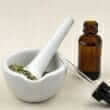Background
- Chumash Indians and other California Indians have used yerba santa (Eriodictyon californicum) and other related species (Eriodictyon crassifolium, Eriodictyon trichocalyx) for many centuries in the treatment of pulmonary (lung) conditions, saliva production, and to stop bleeding of minor cuts and scrapes.
- In the United States and Britain, Eriodictyon californicum was formally used for conditions including influenza, bacterial pneumonia, asthma, bronchitis, and tuberculosis starting in the late 1800s until the 1960s (when drug regulations became more stringent around proof of efficacy). Subsequently, the extracts remained GRAS ("generally regarded as safe") as a flavor for foods, beers, and pharmaceuticals (such as to hide the bitterness of quinine). Eriodictyon plant extracts have also been used in cosmetics.
- Eriodictyon species contain flavones with free radical scavenging (antioxidant) properties, and have therefore been proposed as being beneficial for a number of health conditions. However, there is little scientific study of yerba santa in humans, and effectiveness has not been demonstrated for any specific condition.
References
- Ahmed MS, Galal AM, Ross SA, et al. A weakly antimalarial biflavanone from Rhus retinorrhoea. Phytochemistry 2001;58(4):599-602.
View Abstract - Doostdar H, Burke MD, Mayer RT. Bioflavonoids: selective substrates and inhibitors for cytochrome P450 CYP1A and CYP1B1. Toxicology 2000;144(1-3):31-38.
View Abstract - Gradolatto A, Basly J, Berges R, et al. Pharmacokinetics and metabolism of apigenin in female and male rats after a single oral administration. Drug Metab Dispos 2005;33:49-54.
- Grael CF, Vichnewski W, Souza GE, et al. A study of the trypanocidal and analgesic properties from Lychnophora granmongolense (Duarte) Semir & Leitao Filho. Phytother Res 2000;14(3):203-206.
View Abstract - Huguet AI, Manez S, Alcaraz MJ. Superoxide scavenging properties of flavonoids in a non-enzymic system. Z Naturforsch [C ] 1990;45(1-2):19-24.
View Abstract - Ko WC, Shih CM, Lai YH, et al. Inhibitory effects of flavonoids on phosphodiesterase isozymes from guinea pig and their structure-activity relationships. Biochem Pharmacol 2004;68(10):2087-2094.
View Abstract - Konstantinopoulou M, Karioti A, Skaltsas S, et al. Sesquiterpene lactones from Anthemis altissima and their anti-Helicobacter pylori activity. J Nat Prod 2003;66(5):699-702.
View Abstract - Liu YL, Ho DK, Cassady JM, et al. Isolation of potential cancer chemopreventive agents from Eriodictyon californicum. J Nat Prod 1992;55(3):357-363.
View Abstract - Matsuda H, Morikawa T, Toguchida I, et al. Medicinal flowers. VI. Absolute stereostructures of two new flavanone glycosides and a phenylbutanoid glycoside from the flowers of Chrysanthemum indicum L.: their inhibitory activities for rat lens aldose reductase. Chem Pharm Bull (Tokyo) 2002;50(7):972-975.
View Abstract - Matsuo M, Sasaki N, Saga K, et al. Cytotoxicity of flavonoids toward cultured normal human cells. Biol Pharm Bull 2005;28(2):253-259.
View Abstract - Rechner AR, Smith M, Kuhnle F, et al. Colonic metabolism of dietary polyphenols: influence of structure on microbial fermentation products. Free Rad Biol Med 2004;36:212-225.
- 'T Hart BA, Ip Via Ching TR, Van Dijk H, et al. How flavonoids inhibit the generation of luminol-dependent chemiluminescence by activated human neutrophils. Chem Biol Interact 1990;73(2-3):323-335.
View Abstract - Thiyagarajah P, Kuttan SC, Lim SC, et al. Effect of myricetin and other flavonoids on the liver plasma membrane Ca2+ pump. Kinetics and structure-function relationships. Biochem Pharmacol 1991;41(5):669-675.
View Abstract - Tsimogiannis D, Oreopoulou V. Free radical scavenging and antioxidant activity of 5,7,3',4'-hydroxy substituted flavonoids. Inn Food Sci Emerg Tech 2004;5:523-528.
- van Zanden JJ, Geraets L, Wortelboer HM, et al. Structural requirements for the flavonoid-mediated modulation of glutathione S-transferase P1-1 and GS-X pump activity in MCF7 breast cancer cells. Biochem Pharmacol 2004;67(8):1607-1617.
View Abstract







